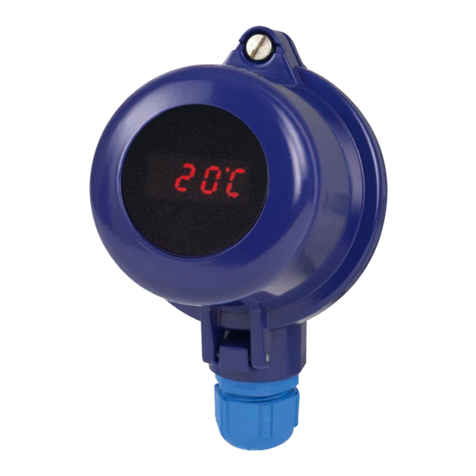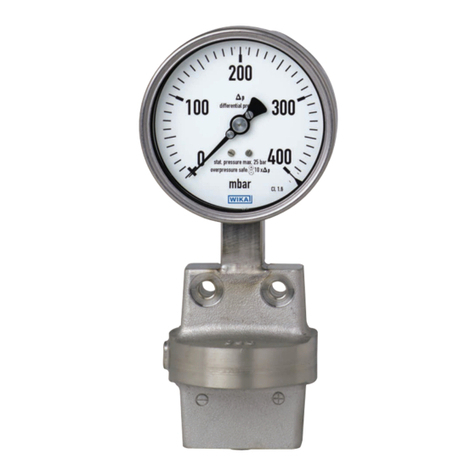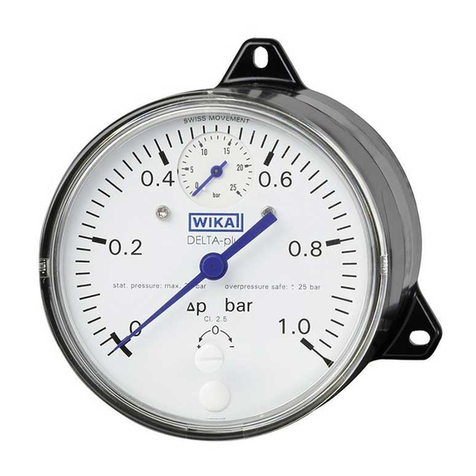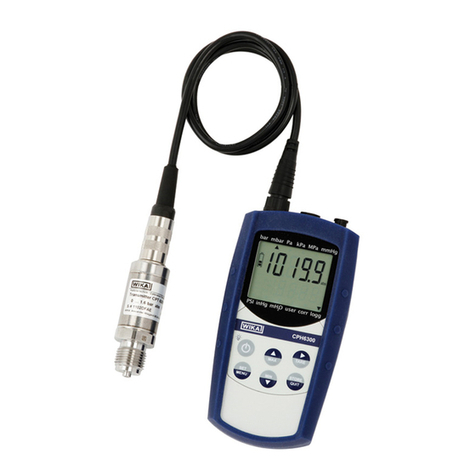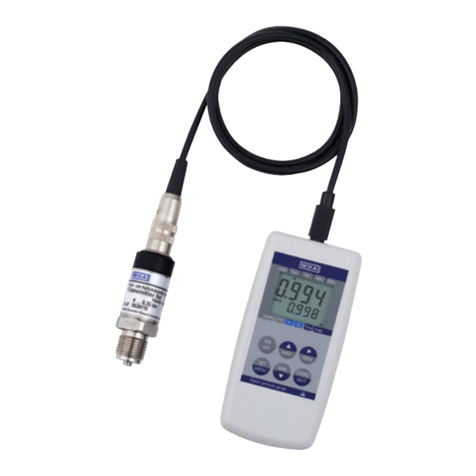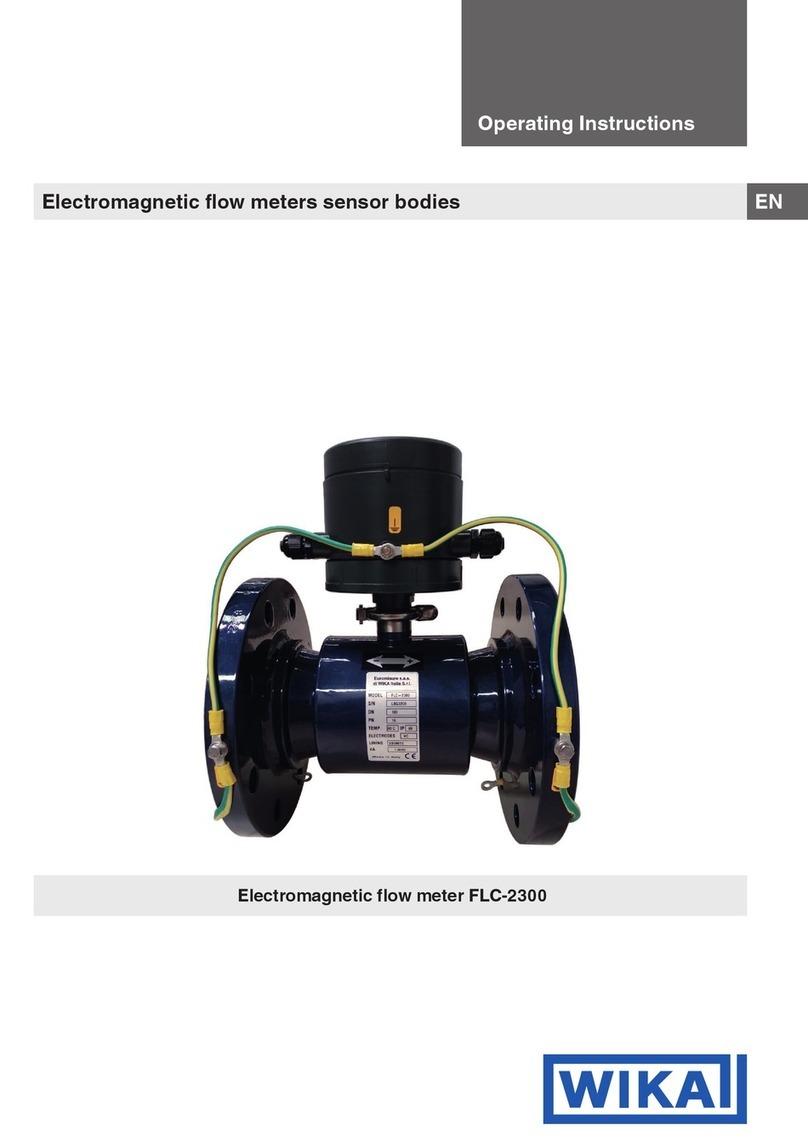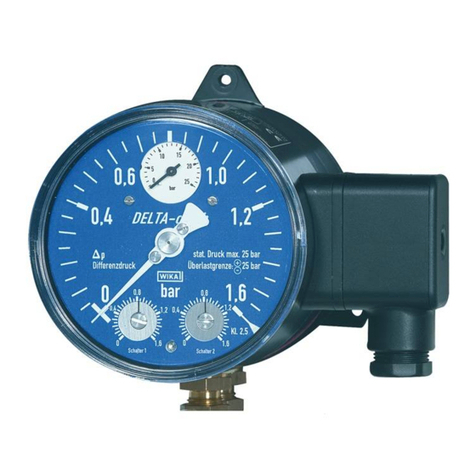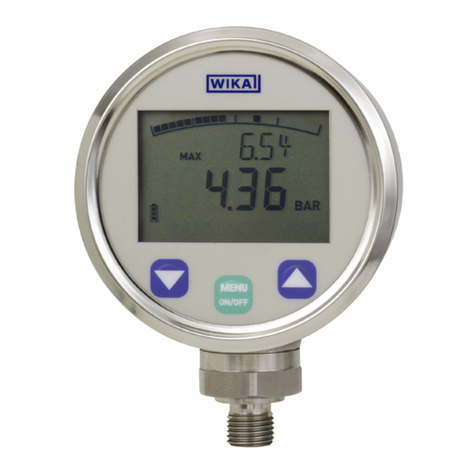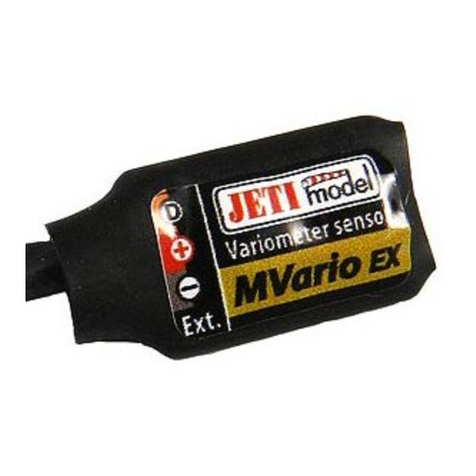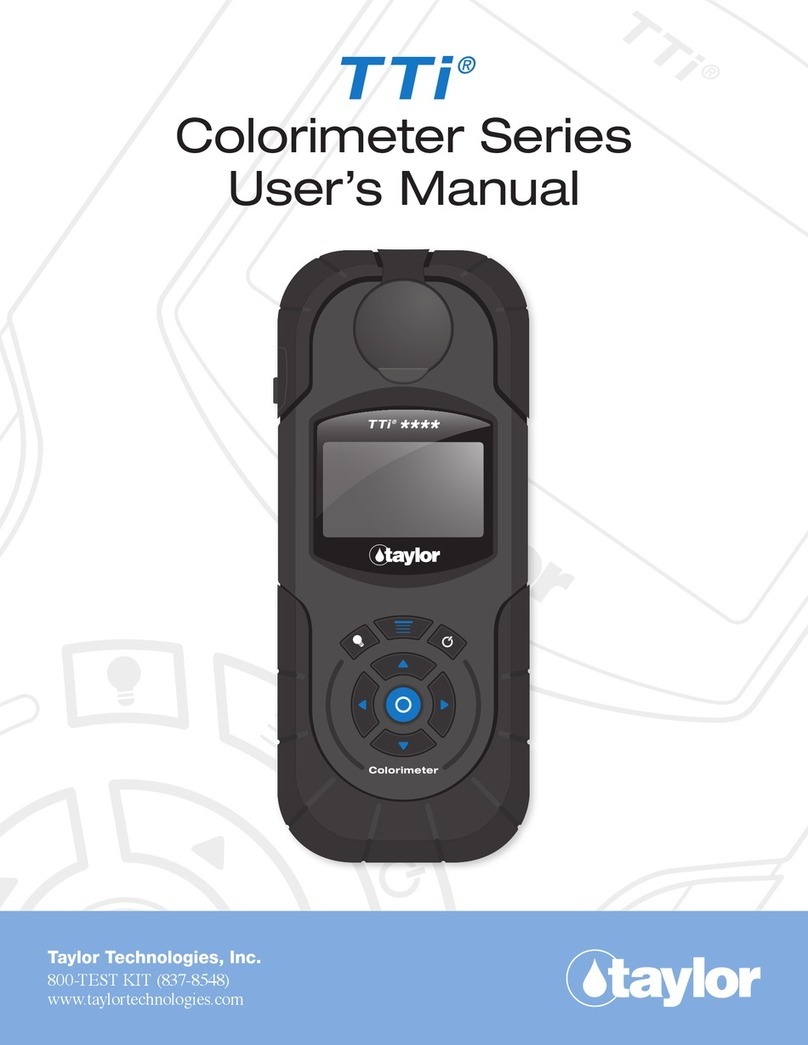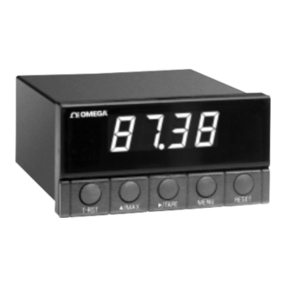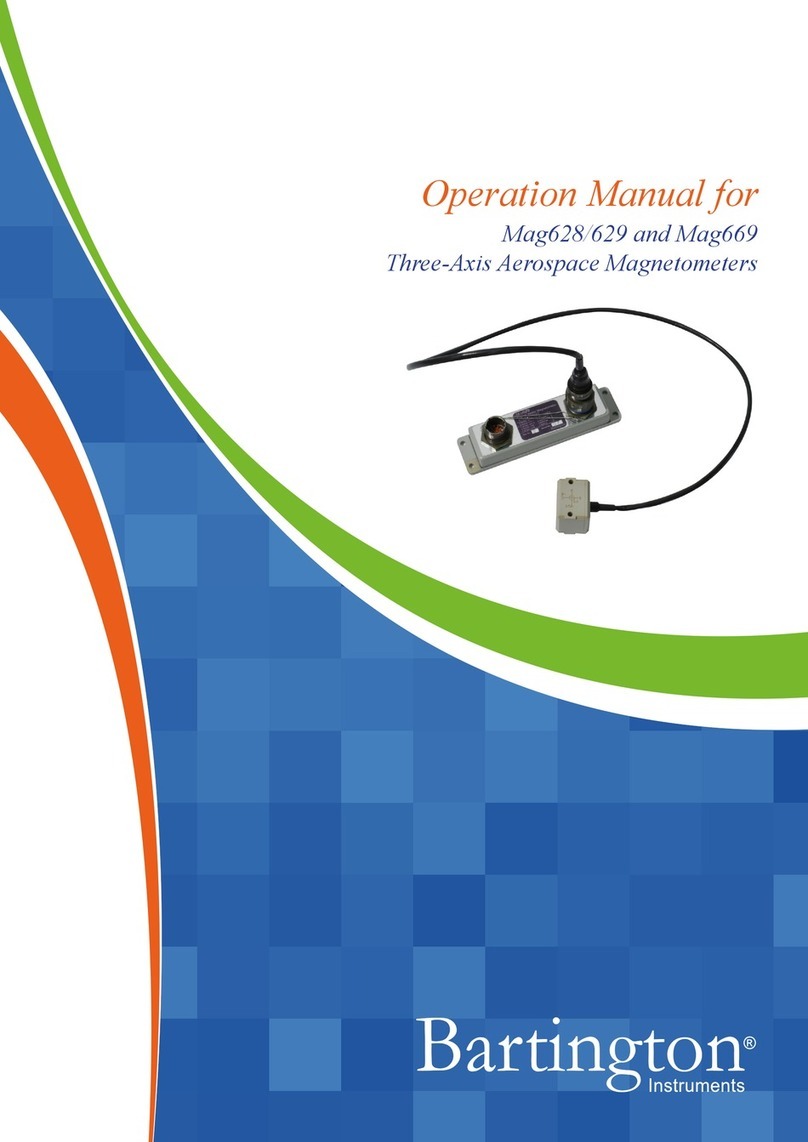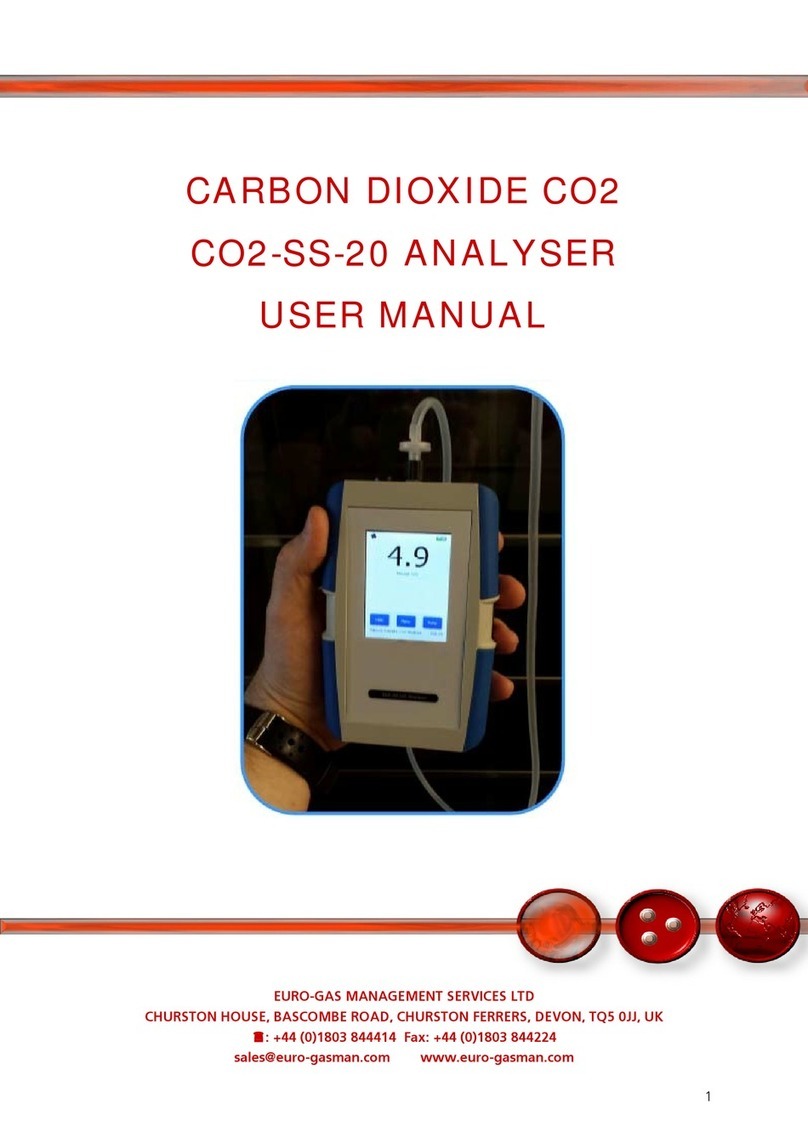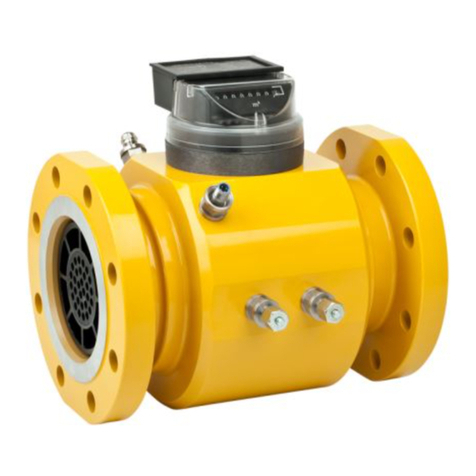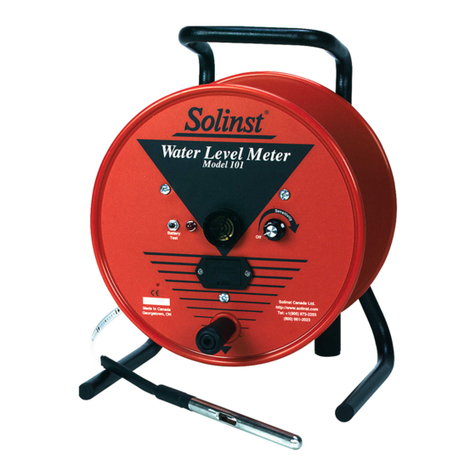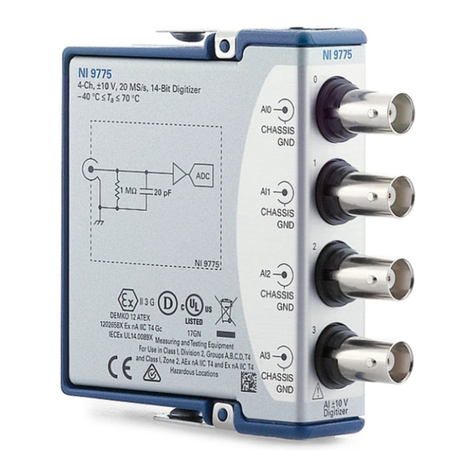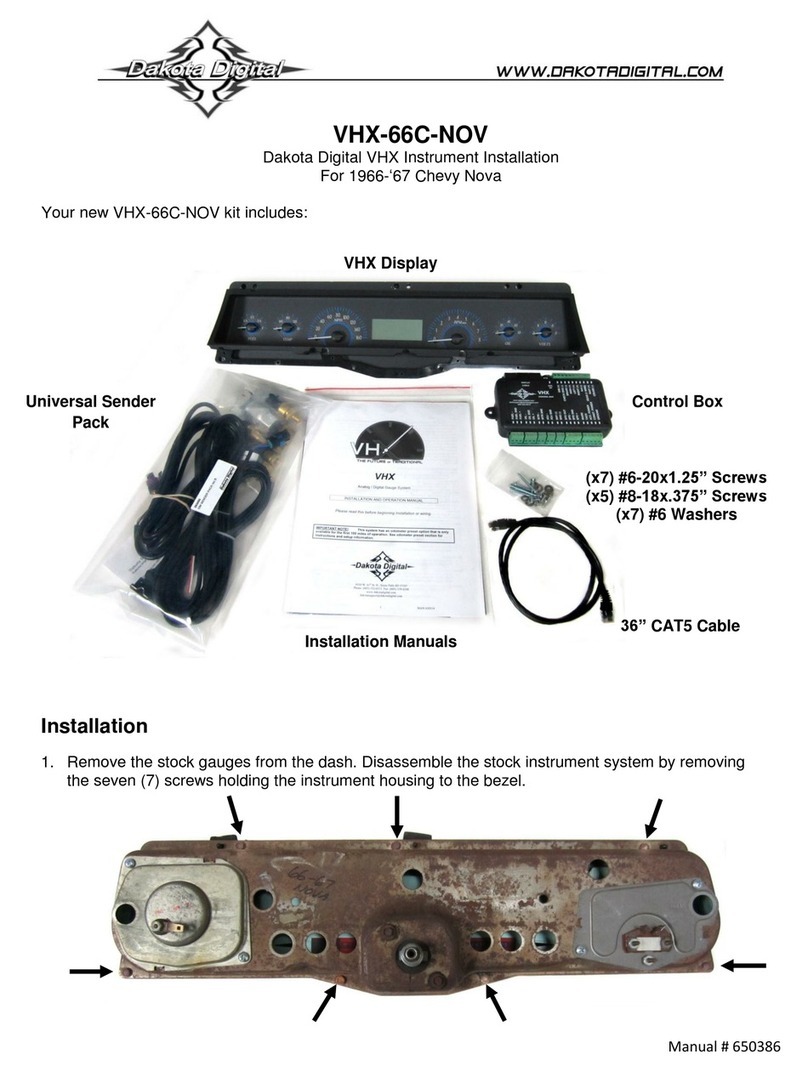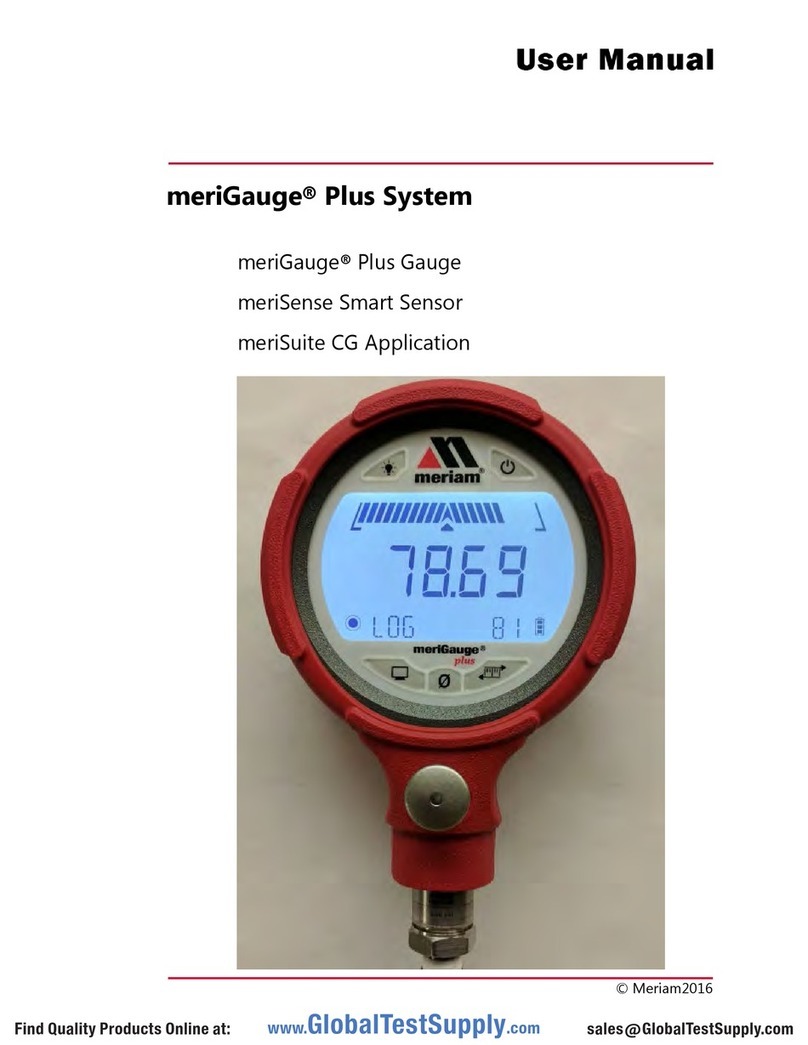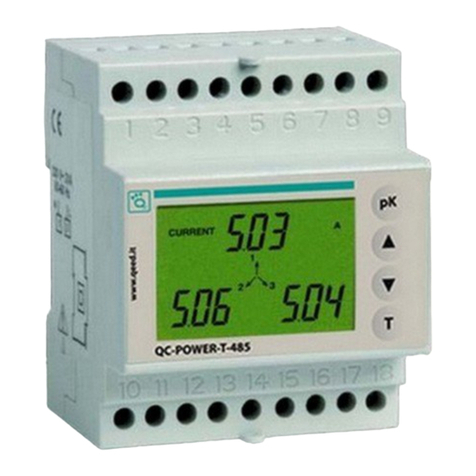WIKA PGS23 User manual

Model PGS23 Model PGS43 Model DPGS43 Model 532.54
EN
DE
Operating instructions
Betriebsanleitung
Pressure gauges with inductive contact model 831,
for hazardous areas
Manometer mit Induktivkontakt Typ 831,
für explosionsgefährdete Bereiche
Examples for pressure gauges with inductive contact model 831

2Pressure gauges with inductive contact model 831, for hazardous areas
14320154.01 06/2019 EN/DE
EN
DE
Operating instructions for pressure gauges with
contact model 831 for hazardous areas
Page 3 - 32
Betriebsanleitung für Kontaktmanometer mit
Kontakttyp 831 für explosionsgefährdete Bereiche
Seite 33 - 61
© 06/2019 WIKA Alexander Wiegand SE & Co. KG
All rights reserved. / Alle Rechte vorbehalten.
WIKA®is a registered trademark in various countries.
WIKA®ist eine geschützte Marke in verschiedenen Ländern.
Prior to starting any work, read the operating instructions!
Keep for later use!
Vor Beginn aller Arbeiten Betriebsanleitung lesen!
Zum späteren Gebrauch aufbewahren!

3Pressure gauges with inductive contact model 831, for hazardous areas
14320154.01 06/2019 EN/DE
EN
Contents
Contents
Declarations of conformity can be found online at www.wika.com.
1. General information 4
2. Design and function 5
2.1 Overview . . . . . . . . . . . . . . . . . . . . . . . 5
2.2 Description. . . . . . . . . . . . . . . . . . . . . . . 5
2.3 Scope of delivery . . . . . . . . . . . . . . . . . . . . 5
3. Safety 6
3.1 Explanation of symbols . . . . . . . . . . . . . . . . . . 6
3.2 Intended use . . . . . . . . . . . . . . . . . . . . . . 6
3.3 Improper use . . . . . . . . . . . . . . . . . . . . . . 7
3.4 Responsibility of the operator . . . . . . . . . . . . . . . . 7
3.5 Personnel qualification. . . . . . . . . . . . . . . . . . . 8
3.6 Skilled personnel . . . . . . . . . . . . . . . . . . . . 8
3.7 Labelling, safety marks . . . . . . . . . . . . . . . . . . 8
3.8 Ex marking. . . . . . . . . . . . . . . . . . . . . . . 9
3.9 Specifications and temperature limits. . . . . . . . . . . . . . 9
3.10 Special conditions for safe use (X conditions) . . . . . . . . . . .11
4. Transport, packaging and storage 11
4.1 Transport . . . . . . . . . . . . . . . . . . . . . . .11
4.2 Packaging and storage . . . . . . . . . . . . . . . . . .12
5. Commissioning, operation 12
5.1 Mechanical connection . . . . . . . . . . . . . . . . . .13
5.2 Electrical connection . . . . . . . . . . . . . . . . . . .16
5.3 Adjusting the set pointers . . . . . . . . . . . . . . . . . .18
5.4 Commissioning . . . . . . . . . . . . . . . . . . . . .18
6. Faults 18
7. Maintenance and cleaning 20
7.1 Maintenance . . . . . . . . . . . . . . . . . . . . . .20
7.2 Cleaning . . . . . . . . . . . . . . . . . . . . . . .20
8. Dismounting, return and disposal 21
8.1 Dismounting . . . . . . . . . . . . . . . . . . . . . .21
8.2 Return . . . . . . . . . . . . . . . . . . . . . . . .21
8.3 Disposal . . . . . . . . . . . . . . . . . . . . . . .22
9. Specications 23
9.1 Standard cable socket (only NS 100 and 160) . . . . . . . . . . .23
9.2 Cable outlet (only NS 50 and 63) . . . . . . . . . . . . . . .23
9.3 Inductive contact model 831 . . . . . . . . . . . . . . . . .23
9.4 Associated isolating amplifiers . . . . . . . . . . . . . . . .24
9.5 Contact pressure gauges . . . . . . . . . . . . . . . . . .25
Annex: EU declaration of conformity 62

Pressure gauges with inductive contact model 831, for hazardous areas4
14320154.01 06/2019 EN/DE
EN
1. General information
1. General information
The contact pressure gauge described in the operating instructions has been designed
and manufactured using state-of-the-art technology. All components are subject to strin-
gent quality and environmental criteria during production. Our management systems are
certied to ISO 9001 and ISO 14001.
These operating instructions contain important information on handling the instrument.
Working safely requires that all safety instructions and work instructions are observed.
Observe the relevant local accident prevention regulations and general safety regulations
for the instrument's range of use.
The operating instructions are part of the product and must be kept in the immediate
vicinity of the instrument and readily accessible to skilled personnel at any time.
Skilled personnel must have carefully read and understood the operating instructions
prior to beginning any work.
The manufacturer's liability is void in the case of any damage caused by using the
product contrary to its intended use, non-compliance with these operating instructions,
assignment of insuciently qualied skilled personnel or unauthorised modications to
the instrument.
The general terms and conditions contained in the sales documentation shall apply.
Subject to technical modications.
Further information:
- Internet address: www.wika.de / www.wika.com
- Relevant data sheet: PM 01.03 (model 111.11.050)
PM 01.05 (model 131.11.050)
PV 22.01 (model PGS21.1x0)
PV 22.02 (models PGS23.1x0, PGS26.1x0)
PV 22.03 (models PGS23.063, PGS26.063)
PV 24.03 (model PGS43.1x0)
PV 27.05 (model DPGS43.1x0)
PV 27.13 (model DPGS43HP.1x0)
PM 02.11 (model 232.35.063)
PV 24.07 (model 432.56)
PV 25.02 (model 532.54)
PV 26.06 (model 632.51)
PM 07.08 (model 736.51)

2. Design and function
2.1 Overview
Example, model PGS23.100, version “S1” per EN 837
Laminated safety glass
Pressure element
Plug of the blow-out device
Pressure compensating valve
Electrical connection with cable box
Set pointer
Adjustment lock
Process connection
2.2 Description
These pressure gauges with inductive
contact(s) have been designed speci-
cally for applications in hazardous areas.
WIKA manufactures and qualies these instruments following EN 837 (gauge pressure),
DIN 16002 (absolute pressure), DIN 16003 (dierential pressure) and DIN 16085 (switch
contacts) in the versions “S1” and “S3”.
Version “S1” per EN 837
This version is designed with a blow-out device at the case.
Safety version “S3” per EN 837
This version is made up of laminated safety glass, a solid bae wall between measuring
system and dial and a blow-out back. In the event of a failure, the operator is protected at the
front side, as media or components can only be ejected via the back of the case.
Switch contact model 831
The built-in electrical inductive contacts are non-contact slot-type inductive proximity
sensors, which are powered from switching ampliers with certied intrinsically safe circuits.
On exceeding the adjustable limit values, their output circuits are either opened or closed.
2.3 Scope of delivery
Cross-check scope of delivery with delivery note.
5Pressure gauges with inductive contact model 831, for hazardous areas
14320154.01 06/2019 EN/DE
EN
2. Design and function

Pressure gauges with inductive contact model 831, for hazardous areas6
14320154.01 06/2019 EN/DE
EN
3. Safety
3. Safety
3.1 Explanation of symbols
WARNING!
... indicates a potentially dangerous situation that can result in serious injury or
death, if not avoided.
CAUTION!
... indicates a potentially dangerous situation that can result in light injuries or
damage to property or the environment, if not avoided.
DANGER!
... identies hazards caused by electrical power. Should the safety instructions
not be observed, there is a risk of serious or fatal injury.
WARNING!
... indicates a potentially dangerous situation in the hazardous area that results
in serious injury or death, if not avoided.
WARNING!
... indicates a potentially dangerous situation that can result in burns, caused by
hot surfaces or liquids, if not avoided.
Information
... points out useful tips, recommendations and information for ecient and
trouble-free operation.
3.2 Intended use
These instruments are used to control process values and to monitor plants in industrial
applications.The contact pressure gauge, with up to 3 integrated model 831 inductive
contacts, displays the process pressure on site and opens/closes circuits at dened
pressure values.
The instrument oers many application possibilities for gaseous and liquid aggressive media
that are not highly viscous or crystallising.
Only use the instrument in applications that lie within its technical performance limits (e.g.
temperature limits, material compatibility, ...).
→ For performance limits see chapter 9 “Specications”.
The instrument has been designed and built solely for the intended use described here, and
may only be used accordingly.
The manufacturer shall not be liable for claims of any type based on operation contrary to
the intended use.

7Pressure gauges with inductive contact model 831, for hazardous areas
14320154.01 06/2019 EN/DE
EN
3. Safety
3.3 Improper use
WARNING!
Injuries through improper use
Improper use of the instrument can lead to hazardous situations and injuries.
▶
Refrain from unauthorised modications to the instrument.
▶
Do not use the instrument with abrasive or viscous media.
Exceptions are diaphragm pressure gauges (models PGS43 and 432.56)
with specially coated diaphragms (abrasive) or versions with open connect-
ing anges (viscous).
Any use beyond or dierent to the intended use is considered as improper use.
3.4 Responsibility of the operator
The instrument is used in the industrial sector. The operator is therefore responsible for legal
obligations regarding safety at work.
The safety instructions within these operating instructions, as well as the safety, accident
prevention and environmental protection regulations for the application area must be
maintained.
The operator is obliged to maintain the product label in a legible condition.
To ensure safe working on the instrument, the operating company must ensure
that suitable rst-aid equipment is available and aid is provided whenever required.
that the operating personnel are regularly instructed in all topics regarding work safety,
rst aid and environmental protection and know the operating instructions and in particu-
lar, the safety instructions contained therein.
that the instrument is suitable for the particular application in accordance with its intended
use.
that personal protective equipment is available.
On the wetted parts of the instrument, small residual amounts of the adjustment
medium (e.g. compressed air, water, oil) can adhere from production. With
increased requirements for technical cleanliness, suitability for the application
must be checked by the operator before commissioning.

Pressure gauges with inductive contact model 831, for hazardous areas8
14320154.01 06/2019 EN/DE
EN
3.5 Personnel qualification
WARNING!
Riskofinjuryshouldqualicationbeinsucient!
Improper handling can result in considerable injury and damage to equipment.
The activities described in these operating instructions may only be carried out
by skilled personnel who have the qualications described below.
3.6 Skilled personnel
Skilled personnel are understood to be personnel who, based on their technical training,
knowledge of measurement and control technology and on their experience and knowledge
of country-specic regulations, current standards and directives, are capable of carrying out
the work described and independently recognising potential hazards.
3.7 Labelling, safety marks
Product label (example)
Model + contact version Ex marking
Article number Case lling
Serial number Pin assignment
Date of manufacture (month/year) Switch contact model and switching function
Before mounting and commissioning the instrument, ensure you read the
operating instructions!
Risk of burns!
Potentially dangerous situation caused by hot surfaces.
The instrument bearing this mark is a safety pressure gauge with a solid bae
wall in accordance with EN 837, safety version “S3”.
3. Safety

9Pressure gauges with inductive contact model 831, for hazardous areas
14320154.01 06/2019 EN/DE
EN
Do not dispose of with household waste. Ensure a proper disposal in accord-
ance with national regulations.
3.8 Ex marking
DANGER!
Danger to life due to loss of explosion protection
Non-observance of these instructions and their contents may result in the loss of
explosion protection.
▶
Observe the safety instructions in this chapter and further explosion protec-
tion instructions in these operating instructions.
▶
Observe the information given in the applicable type examination certi-
cate and the relevant country-specic regulations for installation and use in
hazardous areas (e.g. IEC 60079-14, NEC, CEC).
Check whether the classication is suitable for the application. Observe the relevant national
regulations.
Instruments without PTFE lining
ATEX
IECEx
II 2G Ex ia IIC T6/T5/T4 Gb
II 2D Ex ia IIIB T95°C/T135°C Db
Instruments with PTFE lining
Option with models: PGS43.1x0, 432.56
ATEX
IECEx
II 2G Ex ia IIB T6/T5/T4 Gb
3.9 Specifications and temperature limits
Ingress protection per IEC/EN 60529
For information on the ingress protection of the respective instrument, see chapter
9 “Specications”. For the IECEx assessment, IP20 ingress protection was assumed.
Permissible temperature range
For determining the maximum temperature at the instrument, besides the medium
temperature also other inuences such as the ambient temperature and, if applicable, the
solar irradiation must be taken into account.
3. Safety

T-Ref
T-Ref
Pressure gauges with inductive contact model 831, for hazardous areas10
14320154.01 06/2019 EN/DE
EN
Gas hazardous area
Required temperature class
(ignition temperature)
Permissible temperature range at the
instrument
T6 -20 ... +60 °C
T5 ... T1 -20 ... +70 °C
Dust hazardous area
Maximum surface temperature Permissible temperature range at the
instrument
T135°C -20 ... +60 °C, (+70 °C optional)
T95°C (only with NS 63) -20 ... +60 °C, (+70 °C optional)
The installation should be made in such a way that the temperature range of the instrument,
also considering the eects of convection and thermal radiation, neither exceeds nor falls
below the permissible limits.
The permissible temperature ranges of the contact models must not be exceeded at the
instrument either. If necessary, measures for cooling (e.g. syphon, instrumentation valve,
diaphragm seal etc.) have to be taken.
Compliance with the permissible temperature range during operation must be ensured by
the operator by means of temperature measurement(s) at “T-Ref” within the shown hatched
area(s).
3. Safety
Pressure gauge Dierential pressure gauge

11Pressure gauges with inductive contact model 831, for hazardous areas
14320154.01 06/2019 EN/DE
EN
3. Safety / 4. Transport, packaging and storage
3.10 Special conditions for safe use (X conditions)
i. The temperature class and permitted maximum ambient temperature, are dependent
upon the options tted within the equipment and may not be marked on the equipment
label. The user shall refer to this certicate and to the equipment instructions for details of
the applicable temperature class and ambient temperature range.
ii. The user shall consider that heat may be transferred along the measurement probe and
the equipment shall not exceed the maximum permitted ambient temperature. For further
information, refer to the user instructions.
iii. Models which incorporate a PTFE lining may be marked for use in Group IIB only.The
user shall ensure that such models marked as such are not used in Group IIC Gas nor
Group III dust hazardous areas.
iv. Models which incorporate a PTFE lining may be marked for use in Group IIC gas and
Group IIIB dust hazardous area. Such models also incorporate a warning label advising
the user of a potential electro-static hazard within the process connection area.The user
shall take all necessary precautions to mitigate the risk of electro-static discharge within
the process connection.
v. The equipment may incorporate an integral cable.The user shall ensure that, when
installed, the cable is xed in place and is protected from mechanical damage.
vi. For Group III applications, under certain extreme circumstances, the non-metallic coating
of the enclosure of this equipment may generate an ignition-capable level of electrostatic
charge.Therefore, the equipment shall not be installed in a location where the external
conditions are conducive to the build-up of electrostatic charge on such surfaces.The
user/installer shall implement precautions to prevent the build-up of electrostatic charge,
e.g. locate the equipment where a charge-generating mechanism (such as wind-blown
dust) is unlikely to be present and clean with a damp cloth.
4. Transport, packaging and storage
4.1 Transport
Check the instrument for any damage that may have been caused by transport.
Obvious damage must be reported immediately.
CAUTION!
Damage through improper transport
With improper transport, a high level of damage to property can occur.
▶
When unloading packed goods upon delivery as well as during internal trans-
port, proceed carefully and observe the symbols on the packaging.
▶
With internal transport, observe the instructions in chapter 4.2 “Packaging
and storage”.

Pressure gauges with inductive contact model 831, for hazardous areas12
14320154.01 06/2019 EN/DE
EN
4.2 Packaging and storage
Do not remove packaging until just before mounting.
Keep the packaging as it will provide optimum protection during transport (e.g. change in
installation site, sending for repair).
Permissible conditions at the place of storage:
Storage temperature: -20 ... +70 °C
Avoid exposure to the following factors:
Direct sunlight or proximity to hot objects
Mechanical vibration, mechanical shock (putting it down hard)
Soot, vapour, dust and corrosive gases
Hazardous environments, ammable atmospheres
Store the instrument in its original packaging in a location that fulls the conditions listed
above.
5. Commissioning, operation
Personnel: Skilled personnel
Before installation, commissioning and operation, ensure that the appropriate instrument has
been selected in terms of scale range, design and specic measuring conditions.
WARNING!
Physical injuries and damage to property and the environment caused by
hazardous media
Upon contact with hazardous media (e.g. with ammable or toxic substances),
harmful media (e.g. corrosive, toxic, carcinogenic, radioactive), there is a danger of
physical injuries and damage to property and the environment.
Should a failure occur, aggressive media with extremely high temperature and
under high pressure may be present at the instrument.
▶
For these media, in addition to all standard regulations, the appropriate exist-
ing codes or regulations must also be followed.
▶
Wear the requisite protective equipment.
WARNING!
Physical injuries and damage to property and the environment caused by
media escaping under high pressure
With the pressurisation of the instrument, as a result of poor sealing of the
process connection, media under high pressure can escape.
Due to the high energy of the media that can escape in the event of a failure, the
possibility of physical injuries and damage to property exists.
▶
The sealing of the process connection must be carried out expertly and
checked for leak tightness.
4. Transport, packaging ... / 5. Commissioning, operation

13Pressure gauges with inductive contact model 831, for hazardous areas
14320154.01 06/2019 EN/DE
EN
5. Commissioning, operation
5.1 Mechanical connection
In accordance with the general technical regulations for pressure gauges (e.g. EN 837-2
“Selection and installation recommendations for pressure gauges”).
When screwing the instruments in, the force required for sealing must not be applied through
the case, but only through the spanner ats provided for this purpose, and using a suitable
tool.
For parallel threads, use at gaskets, lens-type sealing rings or WIKA prole sealings at the
sealing face .With tapered threads (e.g. NPT threads), sealing is made in the threads ,
using a suitable sealing material (EN 837-2).
The torque depends on the sealing used. In order to orientate the measuring instrument so
that it can be read as well as possible, a connection with LH-RH union or union nut should
be used. When a blow-out device is tted to an instrument, it must be protected against
being blocked by debris and dirt.
Installation
Nominal position per EN 837-3 / 9.6.6 gure 7: 90° ( ⊥ )
Process connection lower mount
With lled versions the vent valve at the top of the case must be opened before commis-
sioning!
For outdoor applications, the selected installation location has to be suitable for the
specied ingress protection, so that the instrument is not exposed to impermissible
weather conditions.
In order to avoid any additional heating, the instruments must not be exposed to direct
solar irradiation while in operation!
To ensure that the pressure can be safely vented in the case of failure, instruments with
blow-out device or blow-out back must keep a minimum distance of 20 mm from each
object.
Installation with open-ended
spanner
Sealing in the thread
Spanner ats
Sealing face

Pressure gauges with inductive contact model 831, for hazardous areas14
14320154.01 06/2019 EN/DE
EN
Requirements for the installation point
If the line to the measuring instrument is not adequately stable, an instrument mounting
bracket should be used for fastening. If vibrations cannot be avoided by means of suitable
installation, lled instruments should be used. The instruments should be protected against
coarse dirt and wide uctuations in ambient temperature.
Permissible vibration load at the installation site
The instruments should always be installed in locations free from vibration. If necessary,
it is possible to isolate the instrument from the mounting point, e.g. by installing a exible
connection line between the measuring point and the instrument and mounting the instru-
ment on a suitable bracket.
If this is not possible, the following limit values must not be exceeded:
Frequency range < 150 Hz
Acceleration < 0.5 g (5 m/s2)
Test connection
In specic applications (e.g. steam boilers) the shut-o ttings must have a test connection,
so that the instrument can be tested without being dismounted.
Temperature load
The installation of the instrument should be made in such a way that the permissible operat-
ing temperature, also considering the eects of convection and thermal radiation, neither
exceeds nor falls below the permissible limits. Thus the instrument and the shut-o device
must be protected by suciently long measuring lines or syphons.
The inuence of temperature on the indication and measurement accuracy must be
observed.
WARNING!
The actual maximum surface temperature depends not on the equipment itself,
but mainly on the operating conditions.With gaseous substances, the tempera-
ture may increase as a result of compression warming. In these cases it may be
necessary to throttle the rate of change of pressure or reduce the permissible
medium temperature.
Commissioning of pressure compensating valve
Instruments which are tted with a pressure compensating valve
must, following installation, be vented for internal pressure compen-
sation.
Tool: Open-ended spanner SW 9
1. Remove plastic cap
2. Loosen the threaded connection above the valve body
3. Screw the valve body tight, turned through 180°, with ≤ 4.5 Nm
For information on the ingress protection, see Technical information IN 00.18
After commissioning
Before commissioning
5. Commissioning, operation

15Pressure gauges with inductive contact model 831, for hazardous areas
14320154.01 06/2019 EN/DE
EN
Protection of the pressure elements from overload
If the medium is subject to rapid changes in pressure, or pressure surges are expected, then
these must not act directly on the pressure element.The action of the pressure surges must
be dampened, for example with the tting of a throttle section (reduction in cross-section in
the pressure channel) or through the addition of an adjustable throttling device.
Pressure tapping point
The pressure tapping point should be arranged with as large a bore as possible (≥ 6 mm)
via a shut-o device, so that the pressure tap is not distorted by a ow in the medium. The
measuring line between the pressure tapping points and the instrument should have a large
enough internal diameter to prevent blockage and lag in the pressure transmission.
Measuring line
The measuring lines must be as short as possible and should be arranged without sharp
radii in order to avoid any disruptive time lags. When routing these lines, a steady inclination
of approx. 1:15 is recommended.
The measuring line should be designed and installed so that the loads occurring due to
expansion, vibration and thermal eects can be absorbed. With gaseous media, a drain
should be provided at the lowest point; with liquid media, a vent should be provided at the
highest point.
The measuring instruments must be mounted in the common mounting position per
EN 837-1, with a max. permissible incline of 5° on all sides.
Measuring assemblies
Proven measuring assemblies for various types of media.
Liquid media Gaseous media
Filling of the
measuring
line
liquid liquid with
vapour
completely
vapourised
gaseous partially
condensed
(damp)
completely
condensed
Examples conden-
sate
boiling liquids “liquid
gases”
dry air moist air
ue gases
steam
Pressure
gauge above
the tapping
point
Pressure
gauge below
the tapping
point
5. Commissioning, operation

Pressure gauges with inductive contact model 831, for hazardous areas16
14320154.01 06/2019 EN/DE
EN
5.2 Electrical connection
The electrical connection must only be made by qualied skilled personnel. Connection
details and switching functions are given on the product label. Connection terminals and
ground terminal are appropriately marked.The instrument must be connected to the equipo-
tential bonding of the plant.
The instrument may only be operated with corresponding isolating amplier (see
chapter 9.4, model 904.xx).
Performance data (see chapter 9 „Specications“)
Safety instructions for installation
Install instruments in accordance with the manufacturer's instructions and the valid stand-
ards and regulations.
Only connect circuits with the same voltage and type of protection to the switch contacts
and connecting cables.
Size the connecting cables for the largest current strength in the circuits and ensure
sucient UV resistance and mechanical stability.
With exible connecting cables, use isolated end splices. Max. permissible conductor
cross-section 1.5 mm².
Connecting cables must be suited to the ambient temperature range of the application.
5. Commissioning, operation

17Pressure gauges with inductive contact model 831, for hazardous areas
14320154.01 06/2019 EN/DE
EN
The connecting cables must also be suitable for the supplied cable gland (for diameter
range, see below).
Seal the cable entry with the appropriate approved cable glands.
Install the connection cables securely.
M20x1,5
49.5
14336089.01
Standard cable socket (NS 100 and 160)
Only use cable with a
diameter of 7 ... 13 mm
11449056.01
Cable outlet (NS 50 and 63)
5. Commissioning, operation

Pressure gauges with inductive contact model 831, for hazardous areas18
14320154.01 06/2019 EN/DE
EN
5.3 Adjusting the set pointers
The adjustment of the set points is achieved using the adjustment lock in the window with
the aid of the adjustment key (included in delivery; found in standard instruments on the side
of the cable socket).
The set pointers for the inductive contacts are freely adjustable over the full scale range.
For reasons of switching accuracy, switching reliability and service life of the mechanical
measuring systems, the switch points should be between 10 % and 90 % of the measuring
span.
5.4 Commissioning
Pressure surges must be avoided at all costs, open the shut-o valves slowly.
6. Faults
DANGER!
Danger to life from explosion
Through working in ammable atmospheres, there is a risk of explosion which
can cause death.
▶
Only rectify faults in non-ammable atmospheres!
CAUTION!
Physical injuries and damage to property and the environment
If faults cannot be eliminated by means of the listed measures, the instrument
must be taken out of operation immediately.
▶
Ensure that pressure or signal is no longer present and protect against
accidental commissioning.
▶
Contact the manufacturer.
▶
If a return is needed, please follow the instructions given in chapter 8.2
“Return”.
Set pointer
Removable
adjustment key
Adjustment lock
(to set the set pointer, place the adjustment
key here, press it in and set the required
set point)
Pressure compensating
valve
5. Commissioning, operation / 6. Faults

19Pressure gauges with inductive contact model 831, for hazardous areas
14320154.01 06/2019 EN/DE
EN
WARNING!
Physical injuries and damage to property and the environment caused by
hazardous media
Upon contact with hazardous media (e.g. oxygen, acetylene, ammable or toxic
substances), harmful media (e.g. corrosive, toxic, carcinogenic, radioactive),
and also with refrigeration plants and compressors, there is a danger of physical
injuries and damage to property and the environment.
Should a failure occur, aggressive media with extremely high temperature and
under high pressure or vacuum may be present at the instrument.
▶
For these media, in addition to all standard regulations, the appropriate exist-
ing codes or regulations must also be followed.
▶
Wear the requisite protective equipment.
For contact details see chapter 1 “General information” or the back page of the
operating instructions.
Faults Causes Measures
Contact is no longer switching in
accordancewiththespecication.
Electrical connection is
interrupted.
Carry out a continuity test on
the electrical connection lines.
Electrical load unsuitable for
the switch contact model.
Maintain the permissible
electrical loads for the switch
contact model.
Contact contaminated.
Residual current protection device
for the circuit is tripped.
Insulation failure Replace instrument.
Contact chatter (repeated,
short-duration opening and
closing).
Vibrations Decouple the instrument
mechanically.
No pointer movement despite
change in pressure.
Movement blocked. Replace instrument.
For the exchange of the instrument chapters 8 “Dismounting, return and disposal” and
5 “Commissioning, operation” must be observed.
6. Faults

Pressure gauges with inductive contact model 831, for hazardous areas20
14320154.01 06/2019 EN/DE
EN
7. Maintenance and cleaning
7.1 Maintenance
The instruments are maintenance-free.
The indicator and switching function should be checked once or twice every year. For this
the instrument must be disconnected from the process to check with a pressure testing
device.
Testingoflledinstruments
For lled instruments, the level must be checked once or twice every year.
The liquid level must not drop below 75 % of the instrument diameter.
WARNING!
Dangertolifeduetoimpermissiblelling/rellingoftheinstrumentwith
loss of explosion protection
The lling/relling of instruments by non-authorised personnel leads to a loss of
the explosion protection and can lead to damage to the instrument.
▶
Repair of the instruments may only be carried out by authorised bodies.
▶
If a return is needed, please follow the instructions given in chapter 8.2
“Return”.
Repairs must only be carried out by the manufacturer.
7.2 Cleaning
CAUTION!
Physical injuries and damage to property and the environment
Improper cleaning may lead to physical injuries and damage to property and the
environment. Residual media in the dismounted instrument can result in a risk to
persons, the environment and equipment.
▶
Carry out the cleaning process as described below.
1. Before cleaning, correctly disconnect the instrument from the pressure supply, switch it
o and disconnect it from the mains.
2. Use the requisite protective equipment.
3. Clean the instrument with a moist cloth.
Electrical connections must not come into contact with moisture!
CAUTION!
Damage to the instrument
Improper cleaning may lead to damage to the instrument!
▶
Do not use any aggressive cleaning agents.
▶
Do not use any hard or pointed objects for cleaning.
4. Wash or clean the dismounted instrument, in order to protect persons and the environ-
ment from exposure to residual media.
7. Maintenance and cleaning
This manual suits for next models
3
Table of contents
Languages:
Other WIKA Measuring Instrument manuals
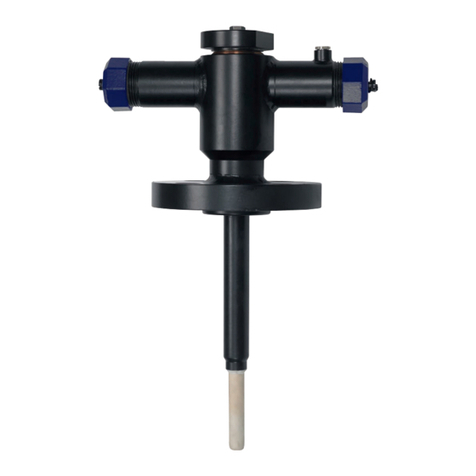
WIKA
WIKA TC84 User manual
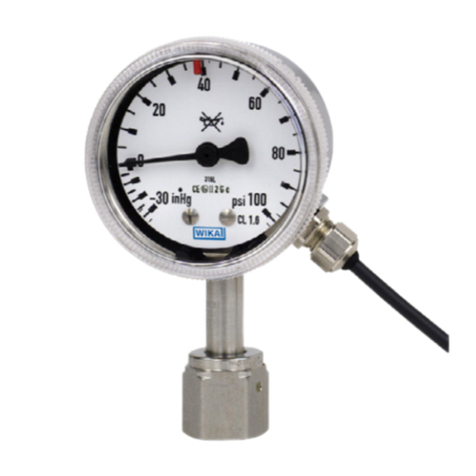
WIKA
WIKA 230.15 User manual
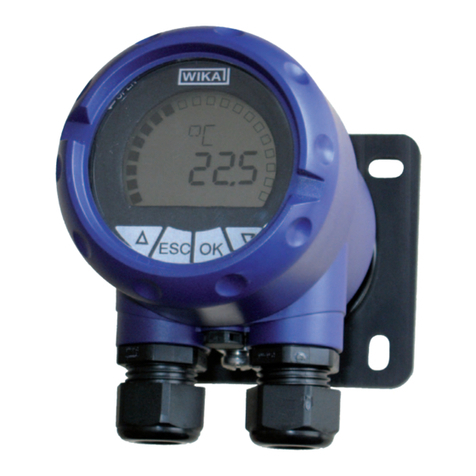
WIKA
WIKA DIH50-F User manual

WIKA
WIKA TR Series User manual
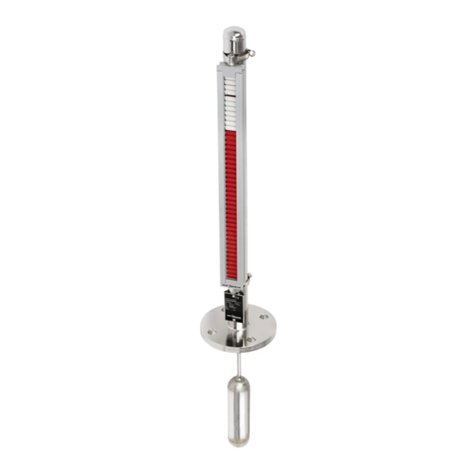
WIKA
WIKA UTN-EX User manual
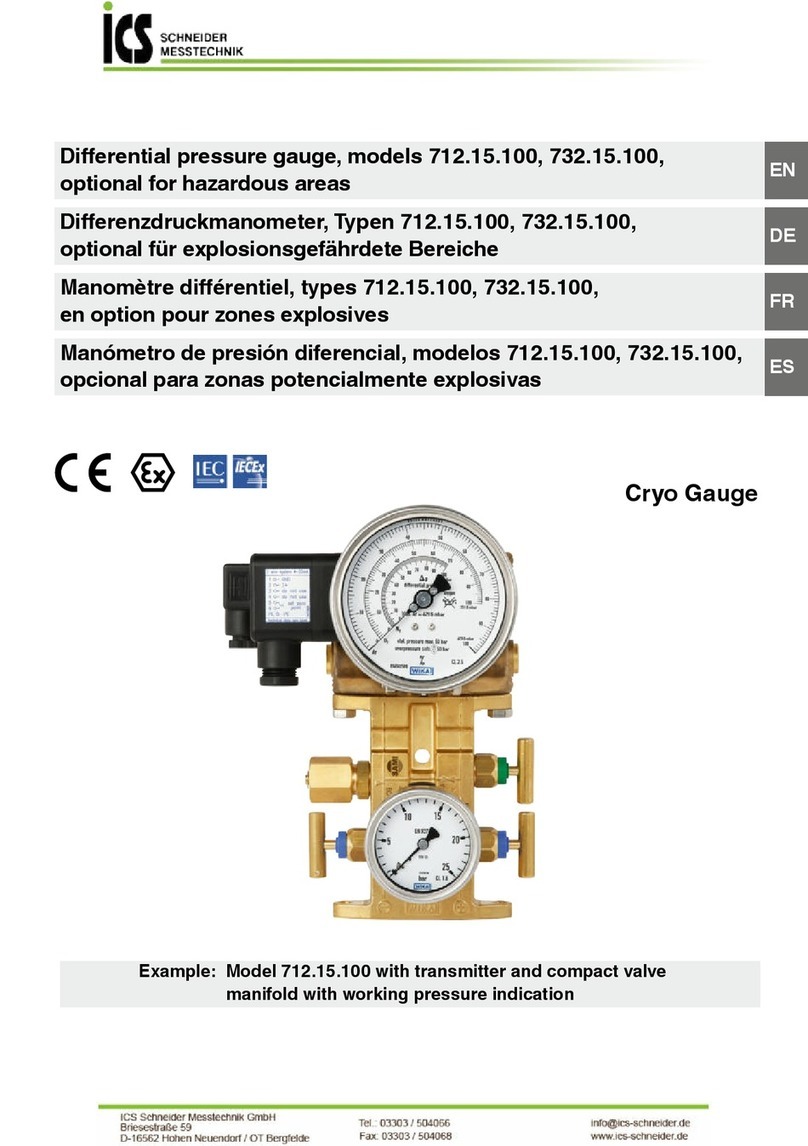
WIKA
WIKA 712.15.100 User manual
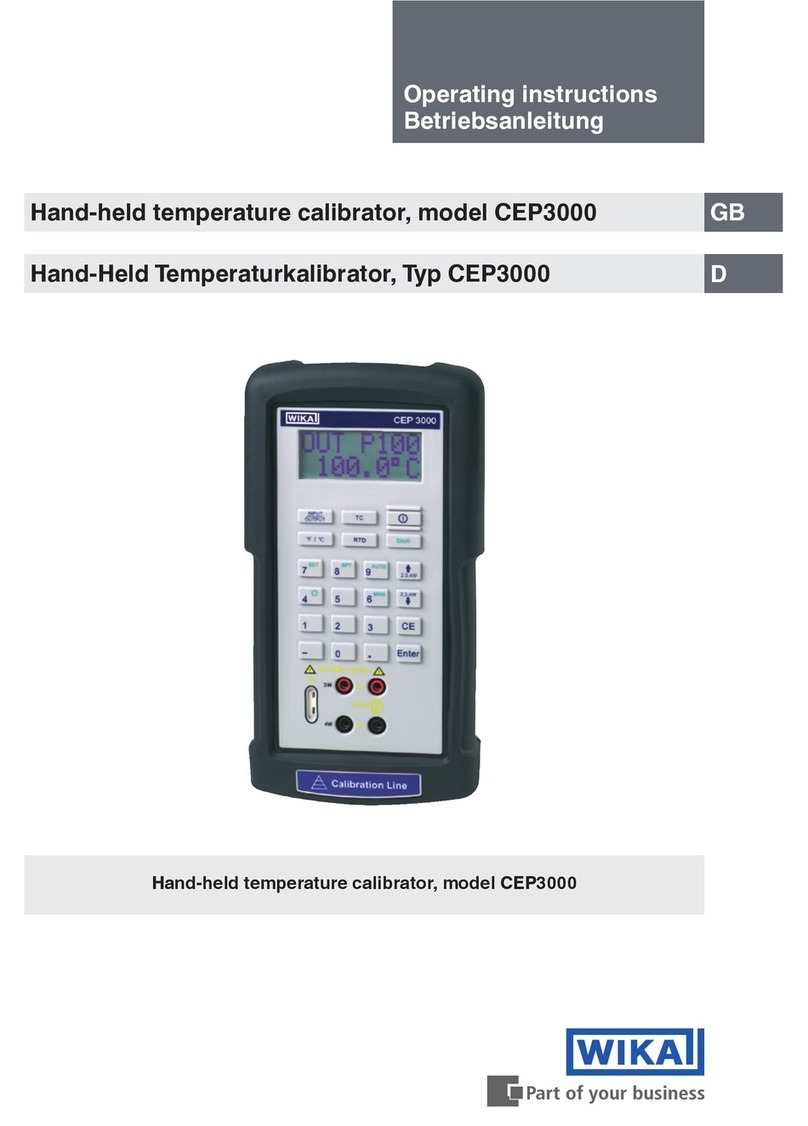
WIKA
WIKA CEP3000 User manual
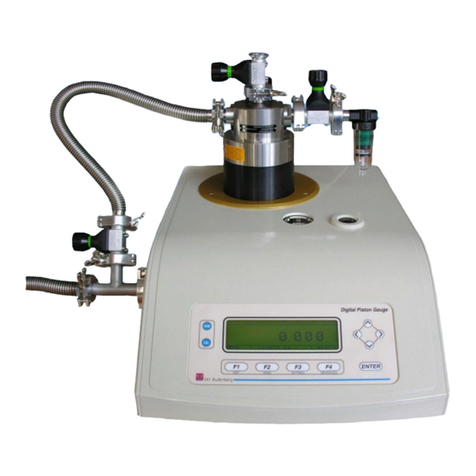
WIKA
WIKA cpd8000-g User manual
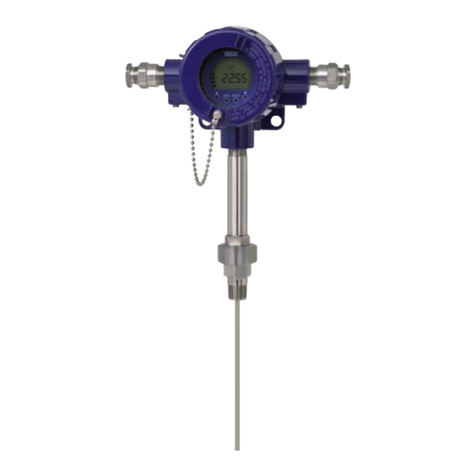
WIKA
WIKA TR12 Series Operating instructions
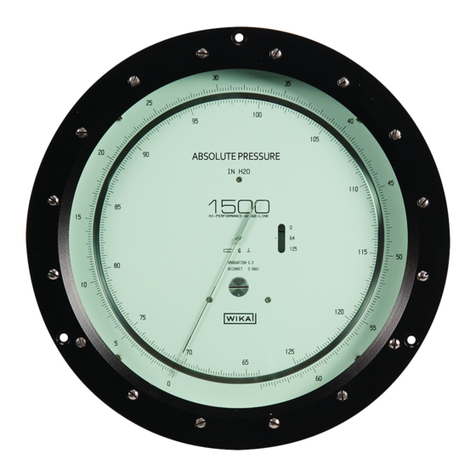
WIKA
WIKA 1500 Series User manual
